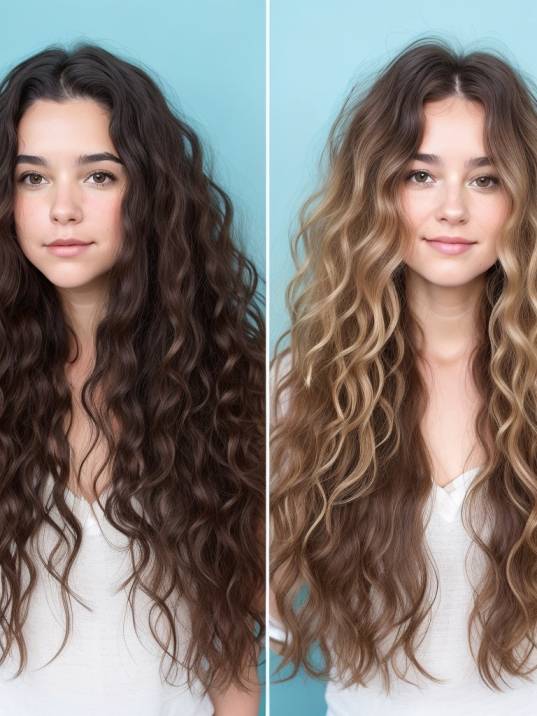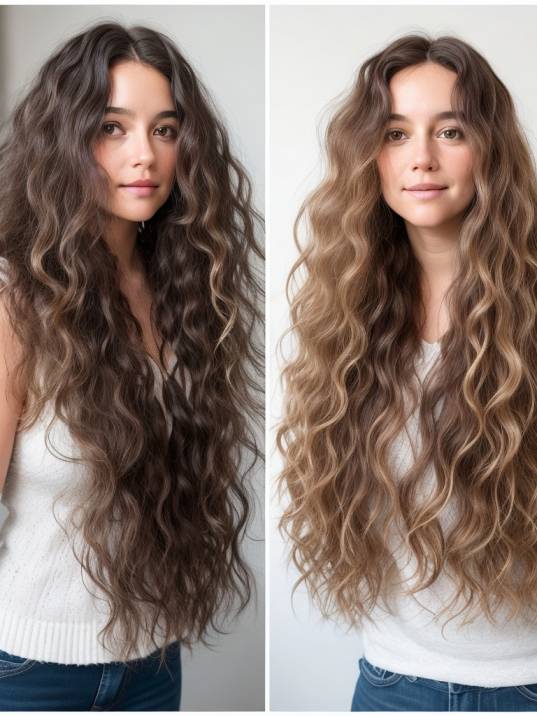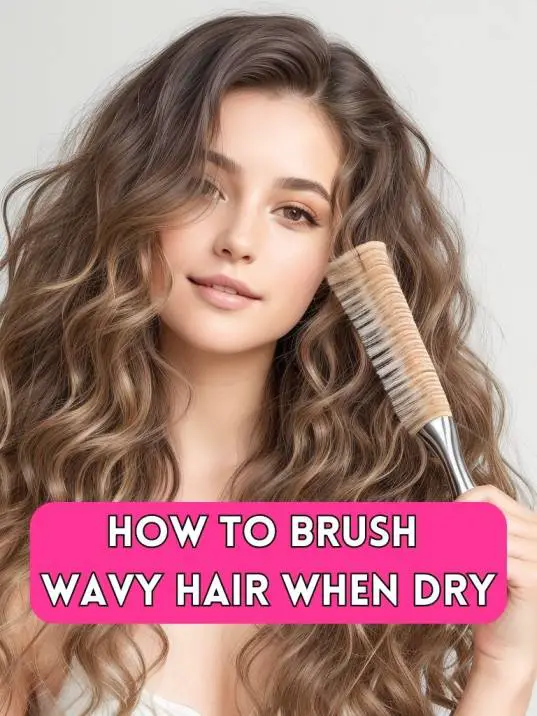Welcome to our expert guide on how to brush wavy hair when dry, your ultimate resource for maintaining stunning, defined waves with care and finesse. Embracing your natural waves can be a transformative journey, and we’re here to walk you through the proper techniques and essential tips to enhance your wavy hair’s beauty without compromising its health. Discover the gentle art of dry brushing for wavy hair and unlock the secrets to effortless, beachy waves you’ll love. Let’s dive in and embrace the beauty of your wavy hair together!
[This post may contain affiliate links. What does that mean to you? Well, if you click on a product and make a purchase, I may get some compensation from you at no charge. If you want to read the boring stuff my full disclosure can be found here.]
Understanding Wavy Hair:

Wavy hair is a hair type characterized by its natural “S” or “W” shaped waves. It falls between straight and curly hair on the hair texture spectrum. Wavy hair is often admired for its effortless and beachy look, but it also comes with its unique set of challenges.
Key Characteristics:
- Wave Pattern: Wavy hair forms loose, gentle waves that can vary in size and shape. The waves may start closer to the roots or begin midway down the hair shaft.
- Volume: Wavy hair tends to have more volume than straight hair but less volume compared to curly hair.
- Texture: It has a soft and touchable texture, which can feel silky or coarse depending on individual variations and care routines.
- Frizz: Wavy hair is prone to frizz, especially in humid conditions or when not properly cared for.
Caring for Wavy Hair:
Caring for wavy hair involves a delicate balance between maintaining the wave pattern and keeping it nourished and healthy.
- Hydration: Wavy hair can sometimes be dry, so regular hydration through deep conditioning treatments and moisturizing products is essential.
- Detangling: Because wavy hair is prone to tangling, gentle detangling with a wide-tooth comb or fingers is recommended, especially when wet.
- Styling Products: Styling products like mousse or curl-enhancing creams can help define and enhance the waves while reducing frizz.
- Avoiding Heat: Excessive heat styling can damage the wave pattern, so it’s best to limit the use of hot tools and opt for heat protection products when styling.
- Trimming: Regular trims help maintain the shape and health of wavy hair by preventing split ends.
- Night Care: Sleeping on a satin or silk pillowcase can reduce friction and frizz, preserving the waves overnight.
Embracing Your Natural Waves:

Instead of trying to change the natural texture of wavy hair, embracing and enhancing its unique beauty is the key to unlocking its full potential. By understanding its specific needs and adopting the right care routine, you can achieve beautiful, healthy waves that are the envy of many.
Preparing Your Wavy Hair for Brushing:
Before brushing wavy hair, it’s essential to prepare it properly to minimize damage and maintain the natural wave pattern. Follow these steps to ensure a gentle and effective brushing experience:
- Detangle Gently: Start by detangling your wavy hair using a wide-tooth comb or your fingers. Begin at the tips and work your way up, gradually removing knots and snarls without pulling or tugging on the hair. Be patient and gentle to avoid breakage.
- Apply a Leave-In Conditioner or Detangling Spray: To make detangling even smoother, consider using a nourishing leave-in conditioner or detangling spray. These products provide additional moisture and slip, making it easier to comb through your waves without causing friction or damage.
- Divide Hair into Sections: If your wavy hair tends to get tangled easily, divide it into manageable sections before brushing. This approach allows you to focus on one section at a time, ensuring you address all knots without overwhelming your hair.
By following these steps, you can effectively prepare your wavy hair for brushing, ensuring a smooth and gentle process that maintains the beauty of your natural waves. Remember, patience and care are key when it comes to handling wavy hair to keep it looking healthy and defined.
Choosing the Right Brush:
Selecting the appropriate brush for your wavy hair is crucial to maintain its health and enhance its natural wave pattern. Here are some factors to consider when choosing the right brush:
- Bristle Type: Opt for brushes with soft and flexible bristles, such as boar bristle brushes or those made from nylon. These bristles gently glide through wavy hair without causing excessive friction or breakage.
- Avoid Hard Plastic Bristles: Brushes with hard plastic bristles can be damaging to wavy hair, leading to breakage and frizz. Steer clear of such brushes, especially when dealing with dry waves.
- Wide-Tooth Comb: For detangling purposes, use a wide-tooth comb instead of a brush. This comb type separates the waves without disrupting their natural pattern, reducing the risk of frizz and breakage.
- Consider the Handle: Look for a brush with an ergonomic handle that provides a comfortable grip. This ensures ease of use and reduces strain on your hands and wrists.
- Size Matters: Choose a brush size suitable for your hair length and thickness. Smaller brushes work well for shorter hair, while larger ones are better suited for longer and thicker wavy hair.
- Flexibility: Opt for brushes that have some flexibility in the bristles. This feature allows the brush to move with the natural contours of your wavy hair, preventing unnecessary tension and damage.
By considering these factors and choosing a brush that is gentle and suitable for your wavy hair type, you can effectively maintain your natural waves while keeping your hair healthy and beautiful.
The Proper Technique for Brushing Wavy Hair When Dry:
Brushing wavy hair when dry requires a gentle approach to preserve the natural wave pattern and minimize frizz. Follow these steps for the proper technique:
- Start at the Tips: Begin brushing your dry wavy hair at the tips, rather than starting from the roots. This prevents unnecessary tension and breakage, as the ends are often more prone to damage.
- Use Downward Strokes: Brush your hair using slow, downward strokes. Avoid brushing vigorously, as this can disrupt the wave pattern and lead to frizz.
- Avoid Brushing from the Roots: Refrain from brushing from the roots to prevent flattening the waves and causing them to lose their volume and shape.
- Section Your Hair: If you have thick or long wavy hair, consider dividing it into sections before brushing. This approach makes the process more manageable and ensures you address all parts of your hair equally.
By following these gentle techniques, you can brush your wavy hair when dry with care, maintaining its natural beauty and promoting healthier, more defined waves. Remember, patience is key, and a gentle touch will help keep your waves looking their best.
Also Read-
Dealing with Frizz and Flyaways:

Frizz and flyaways can be common challenges for wavy hair, but with the right approach, they can be managed effectively. Here are some tips to handle frizz and flyaways:
- Hair Oil or Serum: Apply a small amount of hair oil or serum to your wavy hair to help tame frizz and add shine. Look for lightweight, non-greasy formulas that won’t weigh down your waves.
- Satin or Silk Pillowcase: Swap your cotton pillowcase for a satin or silk one. These smoother fabrics create less friction, reducing the likelihood of frizz and flyaways while you sleep.
- Avoid Over-Brushing: Brushing your wavy hair excessively can lead to frizz. Instead, limit brushing to when necessary and use a gentle technique.
- Humidity-Resistant Products: Consider using styling products that offer humidity resistance, helping to control frizz and maintain the shape of your waves in damp conditions.
- Moisture-Rich Conditioner: Use a moisturizing conditioner regularly to keep your wavy hair nourished and less prone to frizz.
- Anti-Frizz Hair Masks: Incorporate anti-frizz hair masks into your hair care routine. These masks provide deep hydration and can help reduce frizz over time.
By implementing these tips, you can effectively manage frizz and flyaways, maintaining the beauty and definition of your wavy hair. Remember that a combination of proper care and the right products can make a significant difference in keeping your waves looking smooth and vibrant.
Maintenance Tips for Wavy Hair:
- Regular Trims: Schedule regular trims every 6-8 weeks to prevent split ends and maintain the shape of your waves.
- Gentle Cleansing: Wash your wavy hair with a sulfate-free shampoo to avoid stripping natural oils, which can lead to dryness and frizz.
- Deep Conditioning: Treat your wavy hair to a deep conditioning treatment once a week to keep it nourished and hydrated.
- Microfiber Towel: Ditch rough towels and use a microfiber towel to dry your hair gently, reducing frizz and breakage.
- Avoid Heat Styling: Limit the use of heat styling tools to protect the natural texture of your waves. If necessary, use a heat protectant.
- Protective Hairstyles: Opt for loose braids or buns when sleeping or engaging in physical activities to reduce tangling and friction.
- Wide-Tooth Comb: Detangle your wavy hair with a wide-tooth comb, starting from the tips and working your way up.
- Satin or Silk Pillowcase: Sleep on a satin or silk pillowcase to prevent frizz and preserve your waves overnight.
- Avoid Over-Washing: Don’t wash your hair too frequently, as it can strip away natural oils, leaving your waves dry and prone to frizz.
- Embrace Your Waves: Embrace your natural waves and avoid excessive styling or manipulation. Embracing your unique texture will lead to healthier, happier wavy hair.
By following these maintenance tips, you can keep your wavy hair looking its best, ensuring well-defined waves and reduced frizz for a stunning, effortless look.
Avoiding Common Mistakes:

- Brushing Wet Hair: Avoid brushing wavy hair when it’s wet or damp as it is more susceptible to breakage and damage in this state. Instead, detangle gently with a wide-tooth comb or fingers.
- Excessive Heat Styling: Limit the use of heat styling tools, such as flat irons and curling wands, as they can lead to heat damage and disrupt the natural wave pattern.
- Overuse of Hair Products: Using too many hair products can weigh down wavy hair and cause buildup. Use products sparingly and choose those specifically formulated for wavy hair.
- Tight Hairstyles: Avoid pulling your wavy hair into tight hairstyles regularly, as it can cause stress on the hair shaft and lead to breakage.
- Ignoring Trims: Regular hair trims are essential for maintaining healthy wavy hair. Skipping trims can lead to split ends and frayed hair tips.
- Harsh Towel-Drying: Refrain from vigorously rubbing your hair with a towel to dry it, as this can cause frizz and damage to the hair cuticles.
- Chemical Treatments: Be cautious with chemical treatments like bleaching and perming, as they can weaken wavy hair and alter its natural texture.
- Not Protecting Hair from Sun and Chlorine: UV rays and chlorine can be damaging to wavy hair. Wear a hat or use a leave-in conditioner with UV protection when exposed to the sun, and rinse hair thoroughly after swimming in chlorinated water.
By being mindful of these common mistakes and adopting a gentle and caring approach to your wavy hair, you can maintain its natural beauty and keep it looking healthy and vibrant.
Embracing Your Wavy Hair:

- Emphasize Self-Love: Embrace your natural waves as a unique and beautiful part of your identity. Cultivate self-love and appreciation for your wavy hair, recognizing that it sets you apart in a world of diverse hair types.
- Acceptance and Confidence: Embrace your wavy hair journey with confidence. Understand that it’s normal to have “good hair days” and “bad hair days,” and it’s all part of the process.
- Learn from Others: Seek inspiration and guidance from wavy hair communities and influencers. Learn tips and tricks from those who have embraced their wavy hair, sharing experiences and building a sense of camaraderie.
- Experiment with Styling: Try different hairstyles and products to discover what works best for your wavy hair. Embrace versatility and have fun experimenting with different looks while staying true to your natural texture.
- Patience and Growth: Embracing your wavy hair may involve a journey of patience and self-discovery. Be open to growth and change, and remember that caring for your waves is a process that requires time and dedication.
- Positive Reinforcement: Celebrate small victories and progress in your wavy hair care routine. Positive reinforcement will boost your confidence and encourage you to continue embracing your natural waves.
By embracing your wavy hair and incorporating self-love and acceptance into your hair care routine, you can fully appreciate the beauty of your natural waves. Embrace the uniqueness of your wavy hair, and let it be a reflection of your authenticity and individuality. Remember, the journey of embracing your wavy hair is about more than just hair care; it’s about embracing and celebrating your true self.
FAQs (Frequently Asked Questions)
1. How do you brush wavy hair without it getting frizzy when dry?
To brush wavy hair without causing frizz, use a soft and flexible bristle brush, or your fingers, and follow a gentle technique. Start at the tips and work your way up, using downward strokes. Avoid over-brushing, and consider using a leave-in conditioner or hair oil to tame frizz.
2. What brush is best for wavy hair when dry?
A boar bristle brush or a flexible bristle brush is best for wavy hair when dry. These brushes gently detangle and distribute natural oils without causing frizz or disrupting the wave pattern.
3. Should I use a comb or brush on wavy hair?
For detangling, use a wide-tooth comb or your fingers to avoid damaging wavy hair. When dry, opt for a gentle brush with soft bristles to maintain the natural wave pattern.
4. What to do if your wavy hair is dry?
If your wavy hair is dry, incorporate a weekly deep conditioning treatment to add moisture. Use sulfate-free shampoos and hydrating hair products to nourish and restore the hair’s natural oils.
5. Why does my wavy hair get frizzy when I brush it?
Wavy hair can get frizzy when brushed excessively or with the wrong type of brush. Hard plastic bristles can create friction, leading to frizz. Use a soft brush and avoid over-brushing.
6. What makes wavy hair less frizzy?
Using a wide-tooth comb or a gentle brush, like a boar bristle brush, helps reduce frizz in wavy hair. Additionally, applying a small amount of hair oil or serum can help tame frizz and add shine.
7. How many times should you brush your wavy hair?
It’s best to avoid over-brushing wavy hair. Brush it when necessary to detangle, preferably when dry, and use a gentle technique to prevent frizz and breakage.
8. What brush is best for wavy and frizzy hair?
For wavy and frizzy hair, a brush with flexible bristles, such as a boar bristle brush, is ideal. These brushes detangle without causing additional frizz and help distribute natural oils.
9. Can you finger-comb wavy hair?
Yes, finger combing wavy hair is a gentle method of detangling, especially when wet. It minimizes frizz and maintains the wave pattern.
10. Why do my waves disappear when I brush my hair?
Brushing wavy hair when dry can disrupt the natural wave pattern, causing the waves to lose definition temporarily. To maintain your waves, use a gentle brushing technique and consider brushing only when necessary.
11. How do you refresh wavy hair in the morning?
To refresh wavy hair in the morning, mist it with water or a mix of water and leave-in conditioner. Gently scrunch the hair to revive the waves, and avoid brushing to maintain their shape.
12. What to do with wavy hair after shower?
After showering, gently towel-dry or use a microfiber towel to remove excess water from wavy hair. Apply a leave-in conditioner or hair oil to enhance moisture, and then style using a wide-tooth comb or fingers.
13. Should you towel dry wavy hair?
Towel-dry wavy hair gently to avoid frizz and minimize damage. Consider using a microfiber towel or an old T-shirt, which are less abrasive on the hair.
14. Should I let my wavy hair air dry?
Air drying is a preferred method for wavy hair to enhance the natural wave pattern. Avoid heat styling whenever possible to maintain the integrity of your waves.
15. Should wavy hair be wet or damp?
When brushing wavy hair, it’s best to do so when it’s dry or slightly damp. Brushing wet hair can cause more damage and disrupt the wave pattern.
Conclusion:
Congratulations on completing our comprehensive guide on how to brush wavy hair when dry! Armed with gentle techniques and maintenance know-how, you’re now equipped to showcase the true beauty of your natural waves.
Remember, the journey to embracing your wavy hair is a celebration of self-love and authenticity. By nurturing your waves with care and adopting a positive mindset, you’ll discover the captivating allure of your unique hair texture.
So, brush with confidence, experiment with styling, and cherish your wavy hair journey. Embrace your waves, and let them be a statement of your individuality and charm. With the right care and appreciation, your wavy hair will shine with confidence and grace. Happy brushing!

